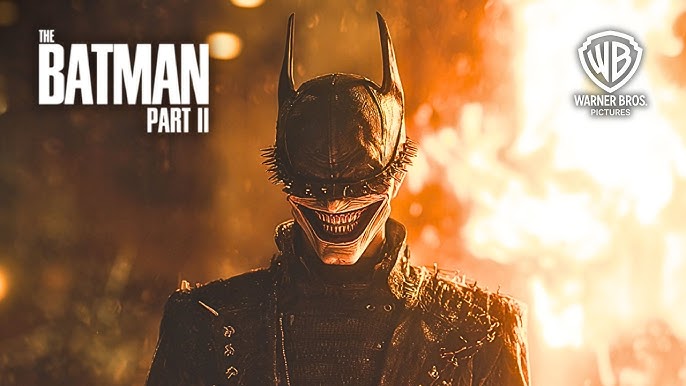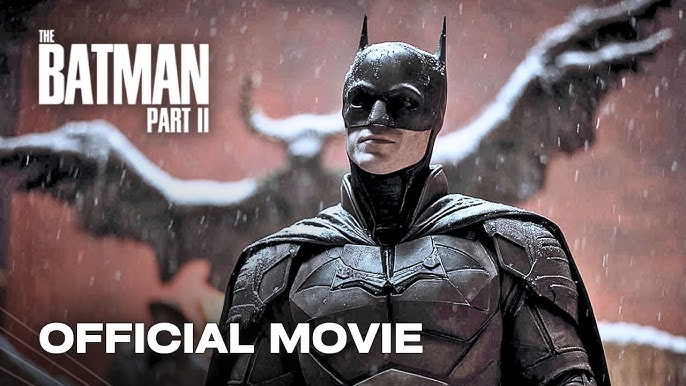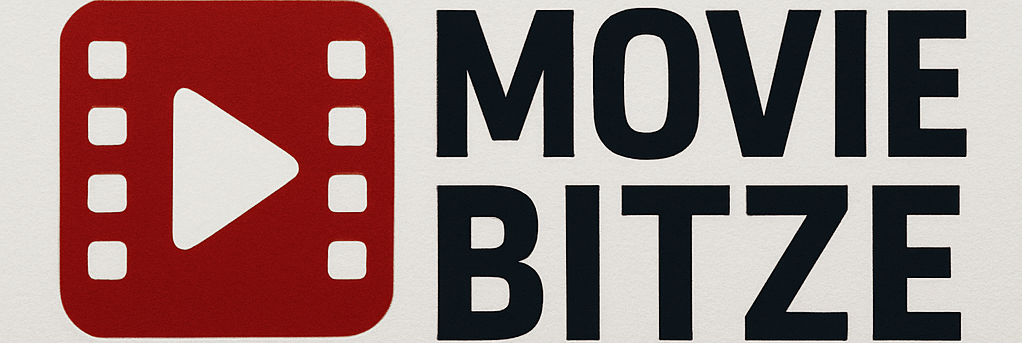The Batman – Part II Explained
The Batman – Part II is not just a sequel; it is the continuation of a meticulously crafted, fully realized cinematic world. Matt Reeves’ first installment presented a Gotham drowning in systemic corruption, with Bruce Wayne (Robert Pattinson) still a vengeful, psychologically tormented figure in his second year of vigilantism. The ending saw a catastrophic flood, the capture of the Riddler, and the dawning realization for Batman: he must become a symbol of hope and renewal for the city, not just fear for its criminals.

The buzz surrounding the script—co-written by Reeves and Mattson Tomlin—and the delayed October 1, 2027 release date confirms one thing: the creative team is taking the time necessary to make the sequel even “scarier,” “deeper,” and “bigger” in its stakes than the original.
This exhaustive 3000-word speculative analysis will serve as your definitive explanation of the likely plot, the three major villain candidates teased by the first film, the crucial role of the ancillary HBO Max series The Penguin, and the inevitable evolution of Bruce Wayne into a true hero for Gotham.
I. The State of Gotham: Drowned, Divided, and Desperate
The foundation of the sequel’s plot is the chaotic state Gotham was left in at the end of The Batman. The city is functionally broken, providing a perfect incubator for a new breed of criminal.
A. The Flood and the Power Vacuum
The Riddler’s (Paul Dano) final act of domestic terrorism saw the seawall breached, flooding large parts of the city, plunging the infrastructure into disarray.
- Thematically: This chaos fulfills Batman’s new mandate. He is no longer fighting against a singular serial killer; he is fighting for the soul of a dying city. His focus must shift from vengeance (Vengeance) to rebuilding (Hope).
- The Rise of Oz Cobb (The Penguin): The flood directly created a power vacuum in the criminal underworld with the death of Carmine Falcone. Colin Farrell’s spin-off series, The Penguin, details how Oswald “Oz” Cobb leverages this anarchy to become the undisputed crime boss. This series functions as the prequel to the crime-side of Part II, meaning Batman will return to a Gotham under the thumb of a new, more ambitious mobster. While Farrell has confirmed his role in the film will be smaller, his ascent is the established status quo that Batman must contend with.

B. The Bruce Wayne Identity Crisis: Renewal or Ruin?
The biggest character arc in the sequel is the evolution of Bruce Wayne. In The Batman, he was a reclusive hermit who only felt alive when wearing the mask.
- The Wayne Family Legacy: The first film left the status of the Wayne legacy stained by the hints of Thomas Wayne’s own past, providing a compelling foundation for the sequel. Bruce must now use his privilege and wealth to heal the city. This means stepping out of the shadows as the reclusive heir and embracing his social role—a difficult task for the emotionally stunted young man.
- Alfred’s Role: Andy Serkis’s Alfred Pennyworth will be crucial in forcing Bruce to confront his responsibilities. The Alfred of this universe is a damaged figure himself, but his focus will be on coaxing Bruce to realize that Batman is a means to an end, not the end itself.
II. The Villain Speculation: Reeves’ “Never Really Been Done” Promise
Director Matt Reeves has continually teased that the main antagonist of The Batman – Part II is a villain who has “never really been done in a movie before,” leading to intense speculation that focuses on three characters that perfectly align with the established grounded, psychological tone.
A. Candidate #1: Hush (Tommy Elliot) – The Personal Attack
Hush is arguably the most logical choice because he directly fulfills the need to explore Bruce Wayne’s past and psyche, which was only teased in the first film.
- The Narrative Fit: Hush’s alter ego is Tommy Elliot, a brilliant surgeon and childhood friend of Bruce Wayne. Tommy harbored a deep, irrational jealousy of Bruce after Thomas Wayne saved Tommy’s mother, preventing Tommy from inheriting his family fortune early. This creates a perfect parallel for the sequel:
- The Attack on Bruce: Hush’s motivation is to systematically destroy Bruce Wayne, using Bruce’s greatest weakness: his emotional isolation and his secret identity. This allows the film to shift its focus from Batman’s detective work to Bruce Wayne’s personal life, which was notably absent in The Batman.
- The Riddler Connection: The Riddler’s initial use of the “Hush” riddle (the hush-hush nature of the Falcone/Wayne scandal) could be a massive piece of foreshadowing. Hush could be a disillusioned former ally who uses the Riddler’s chaos to execute his own surgical plan against the Wayne name.
B. Candidate #2: Hugo Strange – The Psychological Threat

Hugo Strange is a brilliant but deranged psychologist and scientist obsessed with Batman. His inclusion would elevate the film from a procedural thriller to a full-blown psychological horror.
- The Arkham Connection: Strange’s power comes from his control over Arkham Asylum, which is where the Riddler and the embryonic Joker were left. As the director of Arkham, Strange could exploit the city’s madness, using his patients as pawns or conducting twisted experiments.
- Unmasking Batman: In the comics, Strange is famously one of the first villains to deduce Batman’s secret identity. His quest would be to mentally break Batman by attacking the core trauma of his past, fitting perfectly with Reeves’ focus on the psychological fragility of the hero.
- The Wayne Family Legacy: Strange could have a direct, corrupting link to the city’s old money and even the Wayne family history, potentially using his psychiatry to attack the memory of Martha and Thomas Wayne, forcing Bruce to confront his fears about his own inherited psychological stability.
C. Candidate #3: The Court of Owls – The Systemic Final Boss
The Court of Owls is a secretive, elite society of Gotham’s oldest and wealthiest families who control the city from the shadows. While a strong candidate, it feels more suited for the climax of a trilogy.
- Thematic Expansion: The Court would represent the ultimate form of the “corruption” that the Riddler exposed. They are the systemic rot—the old money that has always been pulling the strings.
- The Wayne Link: The Court would force Bruce to confront his family’s role in Gotham’s history. Bruce’s initial focus on street-level crime would suddenly be inverted, forcing him to fight the shadow government from which he himself originates.
- Too Big for Part II?: While elements like the owl symbolism were teased in the first film, introducing an army of undead assassins (The Talons) and an ancient, global conspiracy might risk sacrificing the grounded realism that The Batman so successfully established. They are more likely to be the grand revelation of a third-act plot twist, setting up the final battle in Part III.
III. The Supporting Cast: New Allies and Emerging Threats
The sequel’s narrative will depend heavily on the expanded roles of returning allies and the introduction of new characters from the Bat-mythos.
A. The Commissioner and The Mobster
- James Gordon (Jeffrey Wright): Gordon’s role is set to be the crucial bridge between Batman and the city’s legal structure. With Gotham in chaos, Gordon’s position will be tenuous. The sequel must solidify the trust between Batman and Gordon, transforming their cautious partnership into the lifelong alliance fans know.
- Oz Cobb (The Penguin): Colin Farrell has confirmed his role will be minimal, suggesting he serves as the established crime lord backdrop. His presence solidifies the new order of Gotham’s underworld—an order Batman must disrupt while pursuing the main villain.
B. The Unconfirmed and The Anticipated
- Selina Kyle (Zoë Kravitz): Kravitz’s Selina Kyle rode off into the sunset at the end of the first film. Her return remains uncertain but necessary to continue challenging Batman’s moral compass. If she returns, it will be to aid in a specific, morally grey mission that only she can facilitate.
- The Joker (Barry Keoghan): The five-minute scene between the Riddler and the Joker in Arkham established an alliance of chaos. Keoghan’s Joker is unlikely to be the main villain, but he will serve as the psychological threat in the shadows—the symbol of the unstoppable madness Bruce’s vigilantism attracts. He is the ultimate mirror, waiting for his moment to emerge.
- Robin (Dick Grayson): Speculation is rampant that the sequel will introduce Robin. While Matt Reeves’ vision is often separate from the wider DCU, introducing a Robin (like a street orphan or a young vigilante) would be the ultimate visual representation of Batman fulfilling his new mandate of hope and mentorship. The existence of the separate DCU The Brave and the Bold film featuring Damian Wayne suggests that if a Robin appears here, it will be a distinct, grounded take, likely a version of Dick Grayson.
IV. Thematic Analysis: Vengeance vs. Redemption
The 3000-word scope of the sequel is devoted to the thematic climax of Bruce Wayne’s internal journey: the shedding of the “Vengeance” identity.
A. The Psychology of the Mask
- The Batman ended with Batman realizing he was inadvertently inspiring the city’s worst elements (like The Riddler). Part II must show him actively redefining his symbol. The film must depict Batman saving people—not just catching bad guys—rebuilding trust with the populace, and showing that his purpose is protection, not simply retribution.
- The Bruce Wayne Mask: Bruce Wayne’s emergence into public life will be a constant source of tension. He must learn to perform the role of the aloof billionaire so that he can continue his work as Batman. This creates a new layer of complexity: the Bruce Wayne persona is the ultimate mask he must learn to wear convincingly.
B. The Cinematography and Tone
Reeves and his team are expected to double down on the neo-noir, rain-soaked aesthetic that defined the first film.
- Color Palette: While the first film was dominated by black, red, and the murky yellow of streetlights, Part II should introduce more light—perhaps green (for Poison Ivy or Riddler’s lingering influence) or a sterile white (for Hugo Strange’s Arkham labs) that contrasts with the constant darkness, symbolizing Bruce’s slow ascent out of his depression.
- Musical Score: Michael Giacchino’s iconic, mournful score will evolve. The three-note “Vengeance” motif is expected to be replaced or merged with a theme that reflects Bruce’s growing sense of responsibility and stability.
V. Conclusion: The Long Wait and the Ultimate Payoff
The Batman – Part II is the critical middle chapter of Matt Reeves’ planned trilogy. It is the film where the consequences of the first installment’s chaos are fully realized and where the central character must make his final choice: will he be consumed by the darkness of his city and his past, or will he finally embrace the light of true heroism?
The extended wait until October 1, 2027, is a testament to Matt Reeves’ commitment to delivering a perfectly formed script. The buzz suggests we are getting a film that dives deeper into the emotional damage of Bruce Wayne than any before it, using a terrifying, psychological threat (likely Hush or Hugo Strange) to force him to choose whether to remain the wounded heir or to become the beacon Gotham desperately needs.
The stage is set for a monumental sequel that will solidify Robert Pattinson’s place as the definitive, detective-focused Dark Knight of the modern cinematic era.
